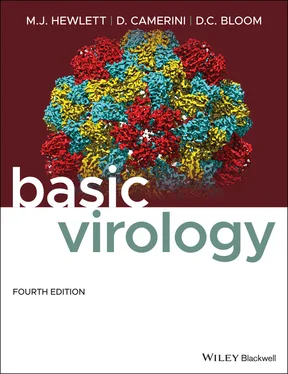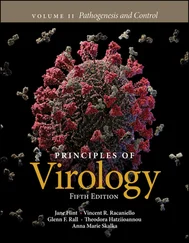It is against this backdrop of hope and concern that we have revised Basic Virology .
This book is based on more than 40 years in aggregate of undergraduate lectures on virology commencing in 1970 given by the coauthors (Wagner, Hewlett, Bloom, and Camerini) at the University of California, Irvine (UCI), the University of Arizona, and the University of Florida. The field of virology has matured and grown immensely during this time, but one of the major joys of teaching this subject continues to be the solid foundation it provides in topics running the gamut of the biological sciences. Concepts range from population dynamics and population ecology, through evolutionary biology and theory, to the most fundamental and detailed analyses of the biochemistry and molecular biology of gene expression and biological structures. Thus, teaching virology has been a learning tool for us as much as, or more than, it has been for our students.
Our courses are consistently heavily subscribed, and we credit that to the subject material, certainly not to any special performance tricks or instructional techniques. Participants have been mainly premedical students, but we have enjoyed the presence of other students bound for postgraduate studies, as well as a good number of those who are just trying to get their degree and get out of the “mill” and into the “grind.”
At UCI, in particular, the course had a tremendous enrollment (approximately 250 students per year) in the past 5–8 years, and it has become very clear that the material is very challenging for a sizable minority studying it. While this is good, the course was expanded in time to five hours per week for a 10‐week quarter to accommodate only those students truly interested in being challenged. Simply put, there is a lot of material to master, and mastery requires a solid working knowledge of basic biology and, most importantly, the desire to learn. This “experiment” has been very successful, and student satisfaction with the expanded course is, frankly, gratifying. To help students acquire such working knowledge, we have encouraged further reading. We have also included a good deal of reinforcement material to help students learn the basic skills of molecular biology and rudimentary aspects of immunology, pathology, and disease. Furthermore, we have incorporated numerous study and discussion questions at the end of chapters and sections to aid in discussion of salient points.
It is our hope that this book will serve as a useful text and source for many undergraduates interested in acquiring a solid foundation in virology and its relationship to modern biology. It is also hoped that the book may be of use to more advanced workers who want to make a quick foray into virology but who do not want to wade through the details present in more advanced works.
Preface to the Second Edition
The text retains our organizational format. As before, Part Iconcerns the interactions of viruses and host populations, Part IIis about the experimental details of virus infection, Part IIIdiscusses the tools used in the study of viruses, and Part IVis a detailed examination of families and groupings of viruses. We have found, in our own teaching and in comments from colleagues, that this has been a useful approach. We have also kept our emphasis on problem solving and on the provision of key references for further study.
What is new in the second edition has been driven by changes in virology and in the tools used to study viruses. Some of these changes and additions include
a discussion of bioterrorism and the threat of viruses as weapons;
updated information on emerging viruses such as West Nile, and their spread;
the current state of HIV antiviral therapies;
discussions of viral genomics in cases where sequencing has been completed;
discussion of cutting‐edge technologies, such as atomic force microscopy and DNA microarray analysis; and
updated glossary and reference lists.
We have, throughout the revision, tried to give the most current understanding of the state of knowledge for a particular virus or viral process. We have been guided by a sense of what our students need in order to appreciate the complexity of the virological world and to come away from the experience with some practical tools for the next stages in their careers.
Preface to the Third Edition
It is with a true sense of our loss that the three of us sit in Irvine, California, Gainesville, Florida, and Taos, New Mexico, working toward completion of this edition. The absence of our friend and colleague, Ed Wagner, is all the more apparent as we write the preface to this latest edition of Basic Virology . In his spirit, we offer our colleagues and students this book that is our latest view of the field that Ed pursued with such passion and dedication.
In this new edition, we have attempted to bring the current state of our discipline into focus for students at the introductory and intermediate levels. To this end, we have done the job of providing the most current information, at this writing, for each of the subjects covered. We have also done some reorganization of the material. We have added three new chapters, in recognition of the importance of these areas to the study of viruses.
The book now includes a chapter devoted completely to HIV and the lentiviruses ( Chapter 20), previously covered along with the retroviruses in general. Given that we continue to face the worldwide challenge of AIDS, we feel that this is an important emphasis.
You will also notice that this version now includes a Part V(“Viruses: New Approaches and New Problems”). This section begins with a consideration of the molecular tools used to study and manipulate viruses ( Chapter 22), follows with coverage of viral pathogenesis at the molecular level ( Chapter 23), and continues with a chapter dealing with viral genomics and bioinformatics ( Chapter 24). We intend that these three chapters will give our students insight into the current threads of molecular and virological thinking. Part Vconcludes with our chapter on “Viruses and the Future” ( Chapter 25), containing updated material on emerging viruses, including influenza, as well as viruses and nanotechnology.
A major change in this edition is the use of full‐color illustrations. We welcome this effort from our publisher, Blackwell Science, and hope that you find this adds value and utility to our presentation.
In conjunction with the expanded coverage, the Glossary has been revised. In addition, all of the references, both text and web‐based, have been reviewed and made current as of this writing.
Most of these changes were either finished or discussed in detail before Ed's untimely passing. As a result, we are proud to say that Basic Virology , Third Edition, bears the welcome imprint of the scientist/teacher who inspired the first one. We hope you agree and enjoy the fruits of this effort.
Marty Hewlett, Taos, NM, USA
Dave Bloom, Gainesville, FL, USA
David Camerini, Irvine, CA, USA
Preface to the Fourth Edition
It seems like only yesterday that Ed and Marty spoke on the phone and said, in effect, “Let's do this thing,” giving birth to Basic Virology . And here we are, completing the revisions for the fourth edition of what we hope will remain a useful and relevant textbook for the teaching of introductory virology to undergraduates.
As it has from its very beginnings, the field of virology is changing at an astounding pace, with newly recognized diseases and their viral causes being reported, accompanied by ever more sophisticated techniques for studying these entities that exist at the fringes of the living world.
In this latest edition we have attempted to capture some of this dynamism, while retaining the organization and pedagogical approach of the original. To that end we have added new and expanded discussions of such agents as Ebola virus, Zika virus, and H1N1 and H7N9 influenza virus, as well as the SARS‐CoV‐2/COVID‐19 pandemic, with information that is current as of this writing. We have modified our presentation of techniques, removing some that are outdated (CoT curves, as an example), retaining the classics that have defined the field (pulse and pulse‐chase labeling), and introducing the newest approaches that are opening new areas of investigation (CRISPR‐Cas).
Читать дальше












